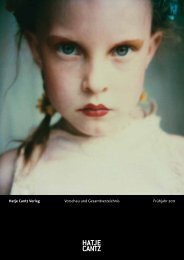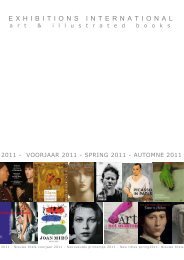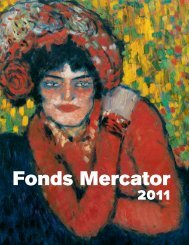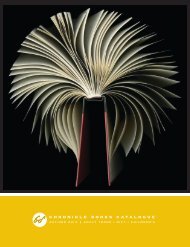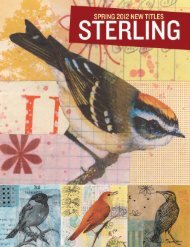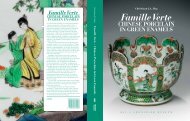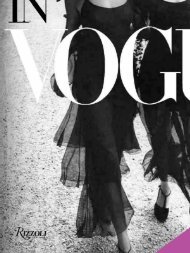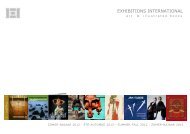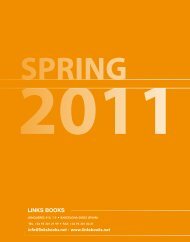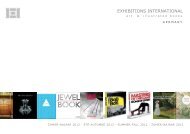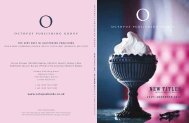01 -[BE/INT-2] 2 KOL +UITGEV+ - exhibitions international
01 -[BE/INT-2] 2 KOL +UITGEV+ - exhibitions international
01 -[BE/INT-2] 2 KOL +UITGEV+ - exhibitions international
You also want an ePaper? Increase the reach of your titles
YUMPU automatically turns print PDFs into web optimized ePapers that Google loves.
Splendour and Glory<br />
Art of the Russian Orthodox Church<br />
Hermitage Museum, Amsterdam<br />
Expo: 19/3/2<strong>01</strong>1 - 16/9/2<strong>01</strong>1<br />
[NL] De Nieuwe Kerk - Hermitage A'dam<br />
V. Boele<br />
Paperback | 280 x 240 mm | 336p | throughout col & bw ill.<br />
ISBN: 9789078653257 | Eng. ed. | March 2<strong>01</strong>1<br />
€ 31,50 [<strong>BE</strong>] / € 29,95 [NL] / € 31,50 [<strong>INT</strong>]<br />
HERMITAGE<br />
9789078653257<br />
Rights: W<br />
From 19 March to 16 September Splendour and Glory will provide the first overview in the Netherlands of the time-honoured spiritual and artistic traditions of the Russian<br />
Orthodox Church. More than 300 religious artefacts - icons, fresco fragments, robes, paintings, historical books and gold and silver objects associated with Christian<br />
worship - form the tangible evidence of this rich and enduring sacred institution.<br />
Religion has played an essential role in Russian society, from the Church's earliest beginnings in 988, when Grand Prince Vladimir officially adopted Orthodox Christianity<br />
as his state religion, until the present. After this 'baptism', the Orthodox faith spread rapidly throughout the realm, adding an extra dimension to church history and art<br />
history.<br />
The exhibition walls will be richly filled with icons, large and small, centuries old and world famous. Icons are sometimes called windows on eternity, for they are believed to<br />
reveal a piece of heaven. Their beauty is without parallel. Attention will focus on the origins and development of Russian icon painting, with Kiev as its birthplace; examples<br />
from various schools will also be displayed, each with their own stylistic characteristics.<br />
Photos of important churches and monasteries in traditional religious centres such as Novgorod and Pskov reveal the flowering of monastic and ecclesiastical life. In<br />
addition to disseminating the Orthodox faith, monastic institutions played a highly significant role in secular society: monasteries often served political and economic<br />
interests while the nuns in convents assumed a range of social tasks. Many objects bear images of saints, of which there are many in the Russian Orthodox Church. The<br />
most revered of these is the Mother of God, followed by St Nicholas whose name day is celebrated twice in Russia, in the spring (22 May) and in the winter (19 December).<br />
The tremendous artistic riches of the Russian Orthodox Church are emphasised by a wealth of magnificent religious treasures from the fifteenth, sixteenth and seventeenth<br />
centuries, when Moscow was the centre of church and art. The exhibition concludes with church art from St Petersburg, religious heart of Russia from 1703 to 1917 and<br />
controlled by the powerful tsars. The Russian Orthodox Church's great importance to both the tsars and the imperial army is clearly demonstrated by Splendour and Glory.<br />
Text and (moving) images visualise and illustrate major themes such as origins and tradition, medieval Russia and the earliest religious centres, and the spread of<br />
Christianity in Russia. Attention is also paid to the Church's suppression by the Soviet regime and its renaissance in the wake of the Soviet Union's collapse in 1991.<br />
For six months the Hermitage Amsterdam will be suffused with the spiritual ambiance of ten centuries of exceptional Russian art.


![01 -[BE/INT-2] 2 KOL +UITGEV+ - exhibitions international](https://img.yumpu.com/19621858/3/500x640/01-be-int-2-2-kol-uitgev-exhibitions-international.jpg)
